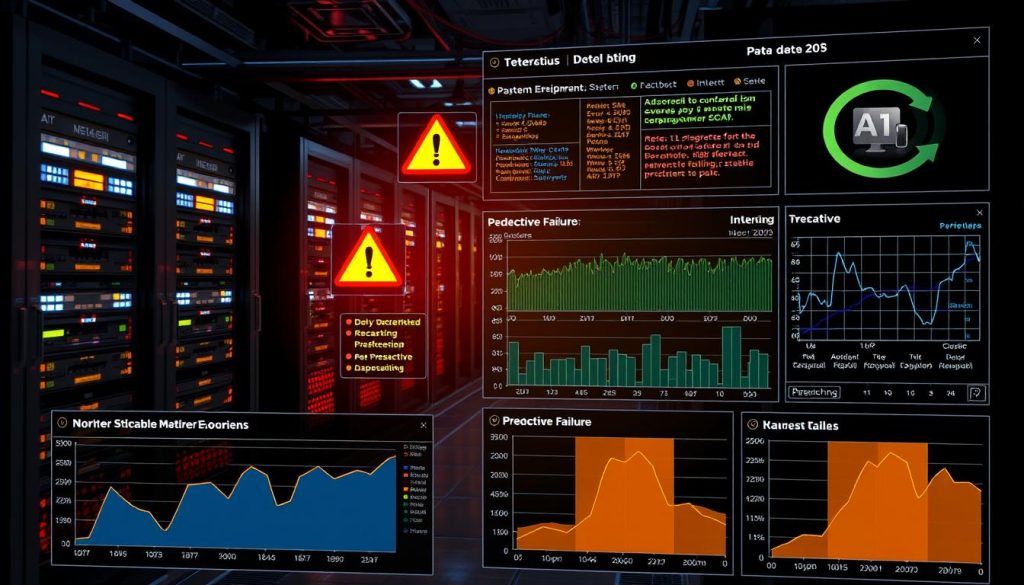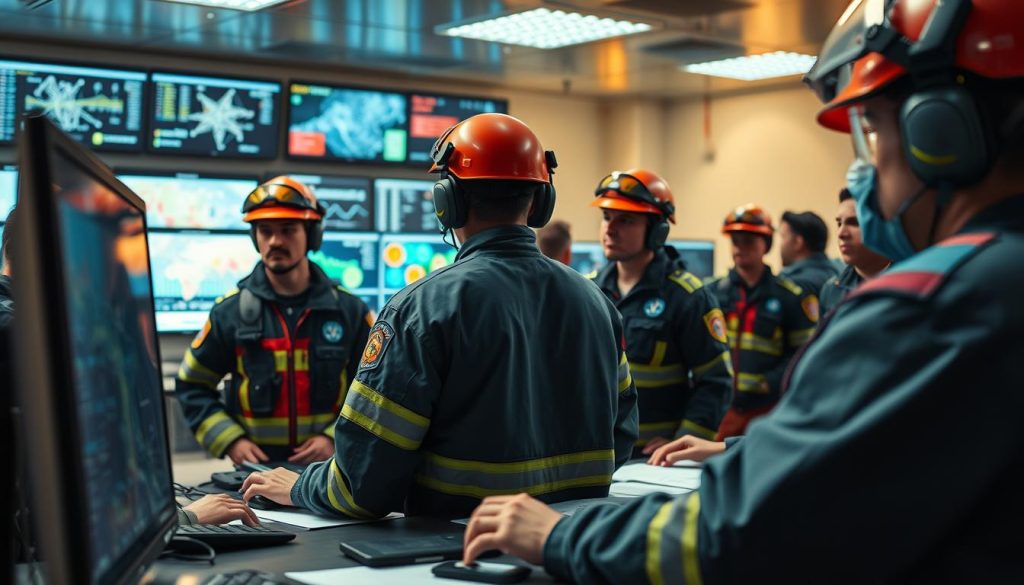AI-Driven Disaster Recovery: Strategies & Tools
August 23, 2025|6:46 PM
Unlock Your Digital Potential
Whether it’s IT operations, cloud migration, or AI-driven innovation – let’s explore how we can support your success.
August 23, 2025|6:46 PM
Whether it’s IT operations, cloud migration, or AI-driven innovation – let’s explore how we can support your success.

AI-driven disaster recovery refers to the incorporation of artificial intelligence, machine learning, and advanced analytics into disaster recovery planning and execution. Instead of purely rule-based playbooks and manual failovers, AI systems ingest telemetry, logs, sensor data, and business context to predict issues, prioritize recovery, and automate orchestration tasks.
This approach augments human operators with predictive insights and automation to reduce time-to-detect and time-to-recover, creating more resilient systems that can respond to threats faster than traditional methods.
AI drives improvements through several key mechanisms that transform how organizations approach disaster recovery planning and execution:
Forecasts potential failures by analyzing historical patterns in hardware, network, and application performance, allowing teams to implement preemptive mitigation strategies before outages occur.
Employs unsupervised or semi-supervised models to identify unusual behavior in metrics, logs, or sensor streams that might indicate impending failures or security breaches.
Implements event-driven workflows that trigger containment, failover, or partial rollbacks automatically based on predefined conditions and confidence thresholds.

“AI doesn’t replace the playbook — it makes the playbook smarter and faster.”
Organizations implementing AI-driven disaster recovery solutions experience several measurable benefits that directly impact business continuity and operational efficiency:
According to the IBM Cost of a Data Breach Report, organizations with AI and automation deployed for security and recovery experienced significantly lower breach costs and faster containment times compared to those without these technologies.
Before implementing AI in your disaster recovery strategy, it’s essential to evaluate your organization’s data quality and risk posture to ensure AI models will have sufficient information to make accurate predictions and recommendations.
| Assessment Area | Key Metrics | Target Threshold |
| Data Quality | Log coverage percentage | ≥95% of critical systems |
| Historical Incidents | Labeled failure datasets | ≥12 months of data |
| Dependency Mapping | Service relationship coverage | 100% of tier 1-2 services |
| Telemetry Granularity | Metrics collection frequency | ≤60 second intervals |
| Model Confidence | Prediction accuracy threshold | ≥85% for automation |
Start by inventorying your critical systems and their associated SLAs, including recovery time objectives (RTOs) and recovery point objectives (RPOs). Then audit your telemetry coverage to identify gaps in monitoring and instrumentation that could limit AI effectiveness.
Selecting the right AI technologies for your disaster recovery strategy depends on your specific recovery objectives, data characteristics, and operational environment.

Supervised classification and regression models excel at failure prediction when you have labeled historical data. These models work well for predictable failure patterns with clear indicators.
Best for: Predictive maintenance
Neural networks can detect complex patterns in time-series data or logs that might be invisible to traditional analysis. Particularly valuable for anomaly detection in large datasets.
Best for: Anomaly detection
NLP models can parse incident reports and unstructured logs to extract insights and identify root causes that might be buried in text-based information.
Best for: Root cause analysis
When selecting AI technologies, consider explainability requirements, especially in regulated industries where you must justify automated decisions. Tree-based models (like Random Forests) and SHAP explanations can provide the transparency needed for compliance.
Successful integration of AI into existing disaster recovery processes requires a thoughtful approach that balances automation with human oversight and builds trust through incremental implementation.
Start with a hybrid approach that keeps humans in the loop for high-impact decisions while automating routine containment and low-risk remediation steps. As confidence in the AI system grows, you can gradually increase automation levels based on performance data.
The market offers a range of AI-enabled tools that can enhance your disaster recovery capabilities. These solutions span monitoring, prediction, orchestration, and incident response categories.
| Category | Commercial Options | Open-Source Options | Key Features |
| Monitoring & Observability | Datadog, Splunk, New Relic | Prometheus + Grafana, Elastic Stack | ML-based anomaly detection, predictive alerts |
| Prediction & Analytics | AWS SageMaker, Google Vertex AI, Azure ML | TensorFlow, PyTorch, scikit-learn | Custom model development, failure prediction |
| Orchestration & Automation | IBM Resiliency, VMware Site Recovery, Zerto | Argo Workflows, Apache Airflow, Kubernetes operators | Automated recovery workflows, dependency management |

When evaluating tools, consider integration capabilities with your existing infrastructure, scalability requirements, and the level of expertise available within your team. Commercial platforms typically offer more comprehensive support and pre-built integrations, while open-source solutions provide greater flexibility for customization.
Implementing AI-driven disaster recovery requires thoughtful architecture design that connects data sources, model serving, and orchestration components in a resilient framework.
A simplified event-driven flow for AI-powered disaster recovery:
Ensure your architecture includes redundant pipelines and fallback mechanisms so that if AI components fail, you can revert to traditional rule-based disaster recovery. This creates a resilient system that doesn’t introduce new single points of failure.
Rigorous testing is essential to validate that AI-driven disaster recovery tools will perform as expected during actual incidents. Implement a comprehensive testing strategy that evaluates both technical performance and operational effectiveness.

Document performance metrics from each test to establish baselines and track improvements over time. This data will help justify continued investment in AI-driven disaster recovery capabilities and identify areas for enhancement.
Effective AI-driven disaster recovery depends on well-maintained models that continue to perform reliably as your environment evolves. Implement a structured approach to model development and lifecycle management to ensure ongoing effectiveness.

Schedule regular model retraining based on data drift metrics or after significant infrastructure changes. Incorporate new incident data to continuously improve prediction accuracy.
Use MLflow or similar tools to version datasets, code, and models. Maintain clear documentation of model parameters and training decisions for audit purposes.
Implement continuous monitoring for model drift, accuracy degradation, and operational metrics. Set alerts for performance thresholds that might indicate model issues.
Always maintain a “kill switch” that allows you to revert to deterministic rules if AI models behave unpredictably. This safety mechanism ensures business continuity even if AI components encounter unexpected scenarios.
Translating AI insights into effective recovery actions requires clear operational procedures that define roles, responsibilities, and decision thresholds.
“Ethical AI in DR is not optional — it’s required to maintain trust during crises.”
Regular drills are essential to maintain readiness and build team confidence in AI-assisted recovery processes. Schedule quarterly exercises that simulate different failure scenarios and require teams to work with AI recommendations.
AI-driven disaster recovery introduces new security, compliance, and ethical dimensions that must be carefully managed to maintain trust and meet regulatory requirements.

Transparency is particularly important when AI systems make or recommend critical decisions during disaster recovery. Ensure stakeholders understand how and why specific actions were taken, especially when automated systems initiate significant recovery steps.
Challenge: Frequent transformer failures causing service disruptions and costly emergency repairs
AI Solution: Implemented LSTM (Long Short-Term Memory) neural networks analyzing time-series sensor data from transformers, combined with graph analytics to model network impact.
Technical Implementation: The LSTM model used a 128-node architecture with 72-hour historical windows, processing temperature, load, and vibration telemetry at 5-minute intervals.
Outcomes:
Key Lesson: High-quality telemetry and domain-specific feature engineering were essential to model success. The utility found that sensor placement optimization improved prediction accuracy by 23%.
Challenge: Slow recovery times for critical transaction systems after outages, resulting in significant financial impact
AI Solution: Deployed supervised classifiers for failure triage combined with automated workflow orchestration using Argo Workflows and AWS Step Functions.
Technical Implementation: The orchestration system used a three-tier confidence model:
Outcomes:
Key Lesson: Phased automation implementation (advisory → semi-automated → fully automated) built trust and reduced risk. The team found that starting with low-risk systems and gradually expanding scope was critical to success.
Challenge: Coordinating multiple agencies during a major hurricane with limited visibility into resource needs and priorities
AI Solution: Implemented NLP for social media and incident report analysis, combined with geospatial analytics and reinforcement learning for resource allocation.
Technical Implementation: The system created real-time heatmaps of incident severity and resource requirements, using a reinforcement learning model that optimized response vehicle routing based on evolving conditions.
Outcomes:
Key Lesson: Data-sharing agreements and privacy safeguards were critical for multi-agency AI deployments. Pre-established governance frameworks enabled rapid implementation during the crisis.

Measuring the effectiveness of your AI-driven disaster recovery implementation requires tracking specific KPIs that reflect both technical performance and business impact.
| KPI Category | Metric | Target Improvement | Measurement Method |
| Recovery Performance | Recovery Time Objective (RTO) | 50% reduction | Timed recovery drills |
| Recovery Performance | Recovery Point Objective (RPO) | 75% reduction | Data loss assessment |
| Detection Efficiency | Mean Time to Detect (MTTD) | 80% reduction | Incident timestamps |
| Resolution Efficiency | Mean Time to Resolve (MTTR) | 50% reduction | Incident duration |
| Model Performance | False Positive/Negative Rate | <5% false positives | Alert validation |
Establish baseline measurements before implementing AI-driven disaster recovery, then track improvements over time. Many organizations aim to cut MTTR by 50% within the first year of adoption, with further improvements as models mature.
Creating effective feedback loops ensures that your AI-driven disaster recovery system continuously improves based on real-world experience and evolving conditions.

Conduct blameless post-mortems after each incident or drill, documenting AI decisions, model outputs, and human actions. Identify opportunities for improvement in both technical and procedural areas.
Use incident data to retrain models, incorporating new failure patterns and recovery outcomes. Maintain a feedback pipeline from incident records to your feature store for continuous learning.
Regularly update recovery playbooks based on lessons learned, adjusting automation rules, confidence thresholds, and human intervention points to reflect real-world performance.
Document and share lessons learned across teams to build organizational knowledge and improve overall resilience. This collaborative approach ensures that insights from one incident benefit the entire disaster recovery program.
As your organization grows and technology evolves, your AI-driven disaster recovery solution must scale accordingly and adapt to new challenges and opportunities.
Regular technology reviews ensure your AI-driven disaster recovery solution remains aligned with industry best practices and emerging capabilities. Schedule annual assessments to identify opportunities for enhancement and address potential gaps.
AI-driven disaster recovery solutions combine predictive analytics, anomaly detection, and automated orchestration to deliver faster, more reliable recovery. The benefits include reduced RTO/RPO, lower costs, improved situational awareness, and better allocation of resources. To adopt these technologies successfully, ensure data readiness, choose appropriate AI technologies, integrate AI with human oversight, and test models through tabletop and live drills.
Real-world case studies from critical infrastructure, enterprise IT, and multi-agency response demonstrate the measurable gains possible: faster detection, shorter downtime, and significant cost savings. As AI technology continues to evolve, organizations that embrace these capabilities will build more resilient operations and maintain competitive advantage.
